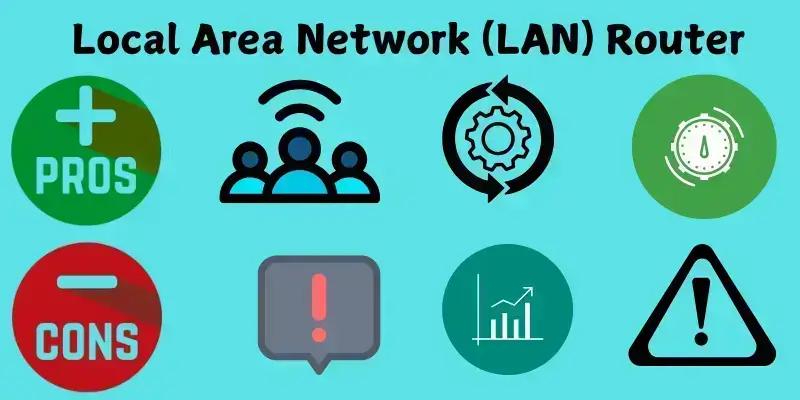What is a Local Area Network Router?
Published: February 3, 2025
Did you know a Local Area Network (LAN) router is essential for connecting multiple devices in homes and offices? Over 90% of businesses rely on LAN routers to communicate seamlessly between computers, printers, and other network devices. Without a properly configured router, data transfer slows down, and connectivity issues arise.

Definition of Local Area Network router
A Local Area Network (LAN) router is a networking device that connects multiple devices within a limited area, such as a home, office, or school. It directs data traffic between computers, smartphones, printers, and other networked devices, ensuring seamless communication. A LAN router can also connect to a modem to provide internet access while efficiently managing network security and traffic.
Difference Between Local Area Network (LAN) and Local Area Network (LAN) Router

Local Area Network (LAN)
- A network that connects multiple devices within a small area (home, office, school).
- Enables communication and resource sharing between connected devices.
- It can function without an internet connection.
- Includes devices like computers, switches, and printers.
- Example: An office network where employees share files and printers.
Local Area Network (LAN) Router
- A device that directs data traffic within a LAN.
- Manages communication between LAN devices and connects the LAN to external networks (like the Internet).
- Helps in organizing and securing network traffic.
- Typically includes features like Wi-Fi, firewall, and DHCP.
- Example: A home Wi-Fi router that connects multiple devices and provides internet access.
Types of LAN Routers
LAN routers come in various types, each catering to different network needs, including wired, wireless, and hybrid options.
- Wired Routers
- Wireless Routers
- Hybrid Routers (Wired + Wireless)
Here’s a breakdown of the three main types of LAN routers:
1. Wired Routers
Connection Type
Uses physical Ethernet cables to connect devices.
Stability
Provides a stable and fast internet connection, ideal for high-speed data transfer.
Security
Offers better security since physical connections are less prone to hacking.
Best for Fixed Devices
Perfect for desktop computers, servers, and other fixed devices.
Limited Mobility
Devices must be physically connected, limiting mobility for mobile devices.
2. Wireless Routers
Connection Type
Allows devices to connect via Wi-Fi, eliminating the need for cables.
Convenience
Perfect for homes and offices where multiple devices like smartphones, laptops, and smart devices need internet access.
Easy Setup
Wireless routers are quick and simple to set up.
Mobility
Devices can move around freely within the network range.
Signal Strength Issues
Can face challenges with signal strength due to interference from walls, distance, or other devices.
3. Hybrid Routers (Wired + Wireless)
Connection Type
Combines both wired and wireless connectivity in a single device.
Flexibility
Supports both Ethernet cable connections and Wi-Fi, catering to different device needs.
Best for Mixed-Use Networks
Ideal for homes or offices with a mix of stationary (wired) and mobile (wireless) devices.
Versatility
Offers the benefits of high-speed wired connections and the convenience of wireless access.
Convenient for Various Devices
Provides the best of both worlds for users with diverse networking needs.
How LAN Routers Work
A LAN router is an essential device that facilitates communication and data transfer between devices within a local network. Here’s how it works:
1. Connecting Devices Within a LAN
Wired Connections
LAN routers connect devices using Ethernet cables, establishing a physical connection for high-speed data transfer.
Wireless Connections
The router broadcasts a Wi-Fi signal for wireless devices, allowing devices like laptops, smartphones, and tablets to connect to the network without physical cables.
Device Communication
The router assigns unique IP addresses to each device on the network, enabling seamless communication between them.
2. Managing Network Traffic
Traffic Control
The router monitors the data flow between devices on the network, ensuring that packets reach their destination without congestion or delays.
Bandwidth Allocation
It manages the bandwidth to prioritize certain traffic, such as video streaming or gaming, to ensure smooth performance.
Security
The router provides a firewall to protect devices from unauthorized access, ensuring that only legitimate traffic can enter or leave the network.
3. Routing Data Packets Efficiently
Packet Forwarding
When a device sends data, the router breaks the data into smaller units called packets. Each packet is routed to its destination using the most efficient path available.
Routing Tables
The router uses routing tables to determine the best path for sending data packets to their destination within the local network or external networks, such as the Internet.
Error Checking
The router checks for errors in the data packets and re-routes them if necessary, ensuring the data reaches its destination intact and without issues.
Setting Up a LAN Router
Setting up a LAN router involves a few key steps to ensure a secure and efficient network. Here’s a guide on how to set a LAN Router properly:
1. Physical Setup and Wiring
Unboxing and Placement
First, remove the router from its box and place it in a central location within your home or office for optimal coverage.
Connecting the Router to the Modem
Use an Ethernet cable to connect the router’s WAN (Wide Area Network) port to the modem’s Ethernet port. This connection will provide internet access to the router.
Connecting Devices
Plug other devices, like computers, printers, or switches, into the LAN (Local Area Network) ports on the router using Ethernet cables, if required. It establishes a wired connection for those devices.
Powering Up
Connect the router to a power source and turn it on. Wait for the router to boot up and establish full connections.
2. Configuring Network Settings
Accessing Router Settings
Open a web browser and type the router’s default IP address (usually something like 192.168.1.1 or 192.168.0.1) into the address bar. You’ll need to log in using the router’s default username and password, usually found on a label on the router.
Setting the Network Name (SSID)
In the router’s settings, please change the default network name (SSID) to something unique that makes it easier to identify your network.
Assigning IP Addresses
Most routers are set to assign IP addresses automatically via DHCP (Dynamic Host Configuration Protocol), but you can manually set static IP addresses for certain devices if needed.
Configuring DNS Settings
You can set up custom DNS servers (like Google DNS or OpenDNS) for better speed and security if necessary.
3. Setting Up Wi-Fi Security (Passwords, Encryption)
Changing Wi-Fi Password
Change the default Wi-Fi password to a strong, unique one to prevent unauthorized access. This password should be a mix of letters, numbers, and symbols.
Choosing Wi-Fi Encryption
Select the highest level of encryption available, such as WPA2 or WPA3, to ensure your network is secure and encrypted. Avoid using WEP, as it’s outdated and vulnerable.
Guest Network Setup
If you want guests to use your Wi-Fi, enable a guest network with a separate password to keep your main network secure.
Disable WPS (Wi-Fi Protected Setup)
If your router has WPS enabled, it’s recommended that you turn it off to prevent potential security vulnerabilities.
Once all these steps are completed, your LAN router will be fully set up, providing both wired and wireless internet access to your devices with strong security.
Advantages and Disadvantages of Local Area Network (LAN) Routers
A Local Area Network (LAN) router plays a vital role in providing connectivity and managing traffic within a network. However, like any technology, LAN routers have their own benefits and drawbacks. Here’s an overview of the key advantages and disadvantages of using a LAN router.

Advantages of LAN Routers
1. Efficient Data Routing
LAN routers help efficiently route data between devices within the local network and external networks, ensuring smooth communication and connectivity.
2. Network Management
LAN routers can manage traffic within the network by prioritizing bandwidth for certain applications or devices, ensuring a stable network performance even during high usage.
3. Improved Security
LAN routers typically include built-in security features, such as firewalls, which protect devices on the network from unauthorized access and external threats.
4. Easy Expansion
LAN routers allow easy network expansion. Additional devices can be added without disrupting the network, making it scalable as the number of connected devices grows.
5. Support for Both Wired and Wireless Connections
Many LAN routers support wired (Ethernet) and wireless (Wi-Fi) connections, offering flexibility and convenience for users with various device types.
6. Cost-Effective
Compared to other network devices, LAN routers are relatively affordable and provide a comprehensive solution for network connectivity, making them a cost-effective option for small businesses and home networks.
Disadvantages of LAN Routers
1. Limited Range (Wireless Routers)
Wireless LAN routers may have a limited coverage area, and their signal strength can be affected by obstacles like walls, distance, and interference from other devices, reducing their overall range.
2. Potential Network Congestion
With multiple devices connected to the network, LAN routers can experience congestion and slow down if there’s insufficient bandwidth or high data usage.
3. Security Risks (If Not Configured Properly)
While LAN routers provide security features, improper configuration (like weak passwords or outdated encryption) can make the network vulnerable to hacking and unauthorized access.
4. Maintenance and Updates
Regular maintenance and firmware updates are necessary to ensure the router’s security and performance. Neglecting these can lead to vulnerabilities and suboptimal performance.
5. Overhead in Complex Configurations
In larger networks, especially in business environments, configuring and maintaining LAN routers with complex settings can become challenging and may require professional expertise.
6. Single Point of Failure
The router acts as the central hub of the network, and if it fails, the entire network’s connectivity is compromised, causing a major disruption.
You may also like these posts:
Conclusion
A well-configured LAN router enhances network efficiency and provides the security and flexibility needed to support both small and large-scale networks. Whether for home or office use, choosing and configuring the right router is essential for ensuring smooth and secure internet access for all connected devices. Proper configuration can prevent security vulnerabilities and optimize network performance, making it a fundamental aspect of any network setup.
FAQS About Local Area Network Router
A LAN router is a device that connects multiple devices in a small area, like a home, office, or school. It helps these devices communicate with each other and access the internet.
A modem connects your home to the internet, while a LAN router connects multiple devices within your home. Some devices combine both functions into one, and this is called a modem router.
Yes, because a router is what creates and manages your Wi-Fi network. Without it, your devices wouldn’t be able to share the internet or communicate with each other wirelessly.
Yes! Even without the internet, a LAN router allows devices to share files, print documents, or connect to local servers within the network.
A wired LAN router connects devices using Ethernet cables, offering faster and more stable connections. A wireless LAN router uses Wi-Fi, allowing devices to connect without cables but with slightly slower speeds.
Most routers support dozens of wired and wireless connections, but too many devices can slow down the network. High-end routers can handle over 100 devices efficiently.
Slow speeds can be caused by too many connected devices, outdated router software, weak Wi-Fi signals, or interference from walls and other electronics. Restarting the router or upgrading it can help.
Yes! You can connect two routers to extend coverage or create separate networks, but you must set them up correctly to avoid conflicts.
Restarting your router once a week helps keep your network fast and stable. It clears temporary issues and refreshes the connection.
Use a strong Wi-Fi password, update the router’s firmware, and restrict remote access. Also, avoid using default login credentials to prevent unauthorized access.





